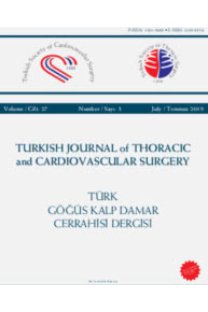Akciğer rezeksiyonları sonrası komplikasyon tahmininde maksimal oksijen tüketim testinin önemi
The importance of maximal oxygen consumption test in the estimation of complications following postoperative lung resections
___
- 1) Olsen GN . Pulmonary physiologic assessment of operative risk. In: Shields TW, LoCiceroIII J, Ponn RB, eds. General Thoracic Surgery. New York: Lipincott Williams, 2000;297-304.
- 2) Karadağ M. Akciğerlerin preoperatif değerlendirilmesi. Özyardımcı N, ed. Nonspesifik Akciğer Hastalıkları. Bursa: Uludağ Üniversitesi Basım Evi, 1999;273-87.
- 3) Smith PK, Wolfe WG. Preoperative assessment of pulmonary function: Quantitative evaluation of ventilation and blood gas exchange. In: Sabiston DC, Spancer FC, eds. Surgery of the Chest. Philadelphia: WB Saunders Company, 1995;1-21.
- 4) Gass GD, Olsen GN. Preoperative pulmonary function testing predict postoperative morbidity and mortality. Chest 1986;89:127-35.
- 5) Ninan M, Sommers KE, Landrenau RJ, et al. Standardized exercise oximetry predicts postpneumonectomy outcome. Ann Thorac Surg 1997;64:328-33.
- 6) Nakagawa K, Nakahara K, Miyoshi S, Kawashima Y. Oxygen transport during incremental exercise load as a predictor of operative risk in lung cancer patients. Chest 1992;101:1369-75.
- 7) Ferguson MK. Preoperative assessment of pulmonary risk. Chest 1999;115:58-63.
- 8) Olsen GN. The evolving role of exercise testing prior to lung resection. Chest 1989;95:218-25.
- 9) Reilly JJ. Preoperative and postoperative care of standart and high-risk surgical patients. Hematol Oncol Clin North Am 1997;11:449-59.
- 10) Tisi GM. Preoperative identification and evaluation of the patient with lung disease. Med Clin North Am 1987;71:399-412.
- 11) Walsh GL, Rodolfo CM, Putnam JB, et al. Resection of lung cancer is justified in high-risk patients selected by exercise oxygen consumption. Ann Thorac Surg 1994;58:704-11.
- 12) Pate P, Tenholder MF, Griffin JP, Eastridge CE, Weisman DS. Preoperative assessment of the high-risk patient for lung resection. Ann Thorac Surg 1996;61:1494-500.
- 13) Smith TP, Kinasewits GT, Tucker WY, Spillers WP, George RB. Exercise capacity as a predictor of post-thoracotomy morbidity. Am Rev Respir Dis 1984;129:730-34.
- 14) Walsh GL, Rodolfo CM, Putnam JB. Resection of lung cancer is justified in high-risk patient selected by exercise consumption. Ann Thorac Surg 1994;58:704-11.
- 15) Bolliger CT, Soler M, Stults P. Evaluation of high-risk lung resection candidates: Pulmonary hemodynamics versus exercise testing. Respiration 1994;61:181-6.
- 16) Eugene J. Maximum oxygene consumption: A phisiologic guide to pulmonary resection. Surg Forum 1982;33:260-2.
- 17) Bechard D, Wetstein L. Assessment of exercise oxygene consumption as preoperative criterion for lung resection. Ann Thorac Surg 1987;44:344-9.
- 18) Morise RC, Peters EJ, Ryan MB. Exercise testing in the evaluation of patients at high risk for complications from lung resection. Chest 1992;101:356-61.
- 19) Gilbreth EM, Weisman IM. Role of exercise stress testing in preoperative evaluation of patients for lung resection. Clin Chest Med 1994;15:389-403.
- ISSN: 1301-5680
- Yayın Aralığı: 4
- Başlangıç: 1991
- Yayıncı: Bayçınar Tıbbi Yayıncılık
Turhan YAVUZ, Erdoğan İBRİŞİM, Ahmet ÖCAL, Vildan ULUSAN, Cumhur TENEKECİ, Ali KUTSAL, İrfan ALTUNTAŞ, İbrahim KILINÇ
Alper SERÇELİK, Feragat UYGUR, Yuri PYA, Birol YAMAK, Altay TANDOĞAN
Brakiyal arterde geç dönemde gelişen post travmatik yalancı anevrizma ve cerrahi tedavisi
Ufuk YETKİN, Serdar BAYRAK, Banu LAFÇI, Gökhan İLHAN, Ali GÜRBÜZ
İnfarktüs sonrası gelişen ventriküler septal defektte erken cerrahi girişim
Murat SARGIN, Aykut Serap AKA, Erol KURÇ, Yeşim BİÇER, Şahin ŞENAY, Okan YÜCEL, Bülent KETENCİ, Gökçen ORHAN
Sağ ventrikül çıkım yolu darlıklarında ksenogreft ve pulmoner homogreft kullanımı
Hasan REYHANOĞLU, Hasan GÜVEN, Arif Ruhi ÖZYÜREK, Tahir YAĞDI, Yüksel ATAY, Ertürk LEVENT, Emin Alp ALAYUNT
Akciğer rezeksiyonları sonrası komplikasyon tahmininde maksimal oksijen tüketim testinin önemi
Cengiz GEBİTEKİN, Ahmet Sami BAYRAM, Hüseyin DÜLGER, Tarık CANDAN, Metin ÖZCAN, Muharrem EROL
Safen ven hazırlanmasında sodyum nitroprussid ve papaverin kullanımı
Ahmet ORUÇ, Nesimi EREN, Kemalettin ERDEM, Fetin YILDIZ, Ömer ÇAKIR
Yeni bir açık Kalp Cerrahisi Merkezi: Kayseri Devlet Hastanesi'nin 3 yıllık deneyimi
Koroner bypass ameliyatı sonrasında gelişen rekürran aortik psödoanevrizma
Yusuf Kenan YALÇINBAŞ, Ersin EREK, Cemal ŞENYUVA, Servet ALAN, Tayyar SARIOĞLU, Ece SALİHOĞLU
